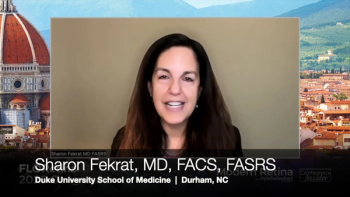
Q&A: Sharon Fekrat discusses retinal manifestations of antipsychotic medications
Sharon Fekrat, MD, FACS, FASRS, shared insights at the American Academy of Ophthalmology (AAO) 2025 meeting in Orlando, Florida, United States, on the retinal manifestations of antipsychotic medications—a topic with important clinical implications for retina specialists. Antipsychotic drugs, used to treat conditions such as schizophrenia, bipolar disorder, and stimulant-induced psychosis, fall into 2 main categories: first-generation (typical) and second-generation (atypical) agents.
Note: The following conversation has been lightly edited for clarity.
Ophthalmology Times Europe: What are your presenting at this year's AAO meeting?
Sharon Fekrat, MD, FACS, FASRS: I will be speaking on retinal manifestations of antipsychotic medications. And as you know, antipsychotic medications treat psychotic illnesses, including schizophrenia and bipolar disorder as well as stimulant psychosis.
OTE: What should ophthalmologists know about these medications?
Fekrat: There are two major classes of antipsychotic medications. The first one is called typical, or first generation antipsychotic medications; and those include thioridazine and chlorpromazine as well as haloperidol. So classically, the well-known retinal toxin is thioridazine, and it can start out by causing a very mild pigmentary and granular retinopathy, usually temporal to the macula and in the macula. But over time, it can cause a nummular atrophy of the retinal pigment epithelium and the choriocapillaris. But it's important to note that thioridazine was discontinued in 2005. Now, there are some generics still available, and once a medicine is discontinued, there can be delayed nummular atrophy and toxicity to the retina. So it is something that retina specialists still do need to be aware of. It is very daily dose dependent, so at doses greater than 800 milligrams a day, that is when it should raise our antenna and that we think about toxicity.
Then there's another class, the second generation, or atypical antipsychotics, and that includes risperidone. And retinal toxicity is much less common with these atypical medications. Risperidol is also known as risperidone, so those are the same things, and cystoid macular edema has been described with that medication. So it's very important to be aware of the retinal manifestations of these antipsychotic medications.
OTE: How have these medications changed over the years?
Fekrat: The newer generation of medications are much less likely to cause retinal toxicity. Now I will also be mentioning psilocybin, those are the "magic mushrooms." And those have no retinal toxicity, but is sometimes used by individuals for self medication. So as retina specialists, we should always remember to think about systemic medications and the retina toxicity that can develop, and keep those in front of our mind when we see a patient with retinal findings, and we're not sure of what the diagnosis is.
Newsletter
Get the essential updates shaping the future of pharma manufacturing and compliance—subscribe today to Pharmaceutical Technology and never miss a breakthrough.













































